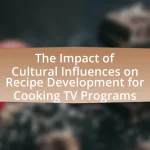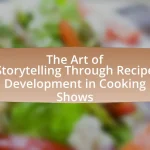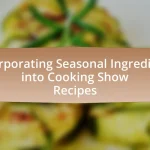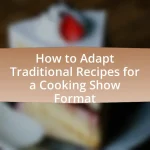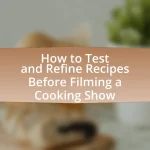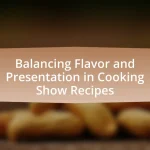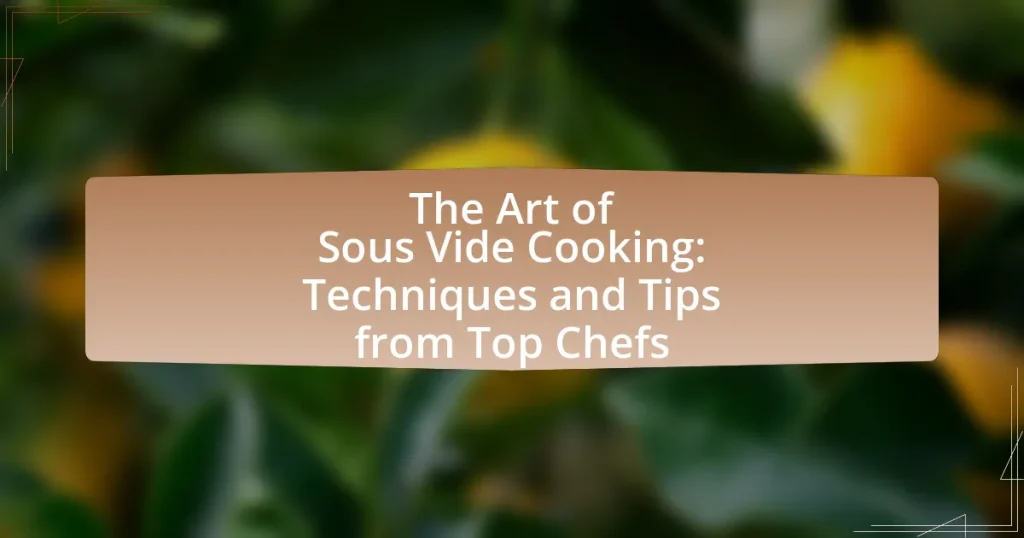Sous vide cooking is a precise culinary technique that involves vacuum-sealing food in a bag and immersing it in a water bath at controlled temperatures, allowing for even cooking and enhanced flavor retention. This article explores the sous vide process, essential equipment, and the critical roles of temperature and time in achieving optimal results. It highlights the benefits of sous vide, including improved texture and nutrient preservation, and discusses innovative techniques used by top chefs. Additionally, the article provides practical tips for home cooks, troubleshooting common issues, and resources for further learning about sous vide cooking.

What is Sous Vide Cooking?
Sous vide cooking is a method of preparing food by vacuum-sealing it in a bag and immersing it in a water bath at a precise, controlled temperature. This technique allows for even cooking and enhanced flavor retention, as the food cooks slowly and evenly, preventing overcooking. The sous vide method has been used in professional kitchens since the 1970s and has gained popularity among home cooks due to its ability to produce consistent and high-quality results.
How does the sous vide cooking process work?
The sous vide cooking process works by vacuum-sealing food in a bag and immersing it in a water bath at a precisely controlled temperature. This method allows for even cooking and retention of moisture, as the food cooks slowly over an extended period, typically ranging from one to 48 hours, depending on the type of food. The temperature is maintained consistently, often within a range of 50°C to 85°C, ensuring that the food reaches the desired doneness without overcooking. This technique is supported by scientific principles of heat transfer and food safety, as cooking at lower temperatures for longer times can effectively kill harmful bacteria while preserving the food’s texture and flavor.
What equipment is essential for sous vide cooking?
Essential equipment for sous vide cooking includes a sous vide immersion circulator, vacuum sealer, and heat-safe bags. The immersion circulator maintains precise water temperature, which is crucial for sous vide cooking, allowing for consistent results. A vacuum sealer removes air from bags, preventing floating and ensuring even cooking. Heat-safe bags are necessary to withstand the cooking temperature without breaking down. These components are fundamental to achieving the desired texture and flavor in sous vide dishes.
How do temperature and time affect sous vide results?
Temperature and time are critical factors that directly influence the texture, flavor, and doneness of sous vide results. Cooking at a precise temperature allows for consistent results, as sous vide techniques typically involve cooking food in a water bath at temperatures ranging from 50°C to 85°C, depending on the desired outcome. For example, cooking steak at 56°C for one to four hours results in a medium-rare texture, while increasing the temperature to 60°C alters the doneness to medium.
Time also plays a significant role; longer cooking times can tenderize tougher cuts of meat, as the low and slow method breaks down collagen effectively. Research indicates that cooking a tough cut like brisket at 70°C for 24 hours yields a tender and flavorful result, while cooking it for just 12 hours may not achieve the same level of tenderness. Therefore, both temperature and time must be carefully calibrated to achieve optimal sous vide results, ensuring that the food is cooked evenly and retains its intended flavor and texture.
What are the key benefits of sous vide cooking?
The key benefits of sous vide cooking include precise temperature control, enhanced flavor retention, and improved texture of food. Sous vide cooking allows food to be cooked evenly at a specific temperature for an extended period, which prevents overcooking and ensures consistent results. Research indicates that sous vide can enhance the flavor profile of meats and vegetables by allowing them to cook in their own juices, leading to a more intense taste. Additionally, the gentle cooking process helps maintain the food’s moisture and tenderness, resulting in a superior texture compared to traditional cooking methods.
How does sous vide enhance flavor and texture?
Sous vide enhances flavor and texture by cooking food in a vacuum-sealed bag at precise, low temperatures, allowing for even heat distribution and moisture retention. This method prevents the loss of juices and flavors that typically occurs with traditional cooking methods, resulting in more concentrated tastes. Additionally, the controlled environment allows proteins to break down more effectively, leading to a tender texture. Studies have shown that sous vide cooking can improve the tenderness of meats by up to 30% compared to conventional methods, as the low temperatures facilitate the breakdown of collagen without overcooking the meat.
Why is sous vide considered a healthier cooking method?
Sous vide is considered a healthier cooking method because it allows for precise temperature control, which helps retain nutrients and reduces the risk of overcooking. Cooking at lower temperatures for extended periods preserves vitamins and minerals that can be lost in traditional cooking methods, such as boiling or frying. Research indicates that sous vide cooking can maintain up to 90% of certain nutrients, compared to only 50% retention in conventional methods. This nutrient preservation contributes to a healthier overall meal.
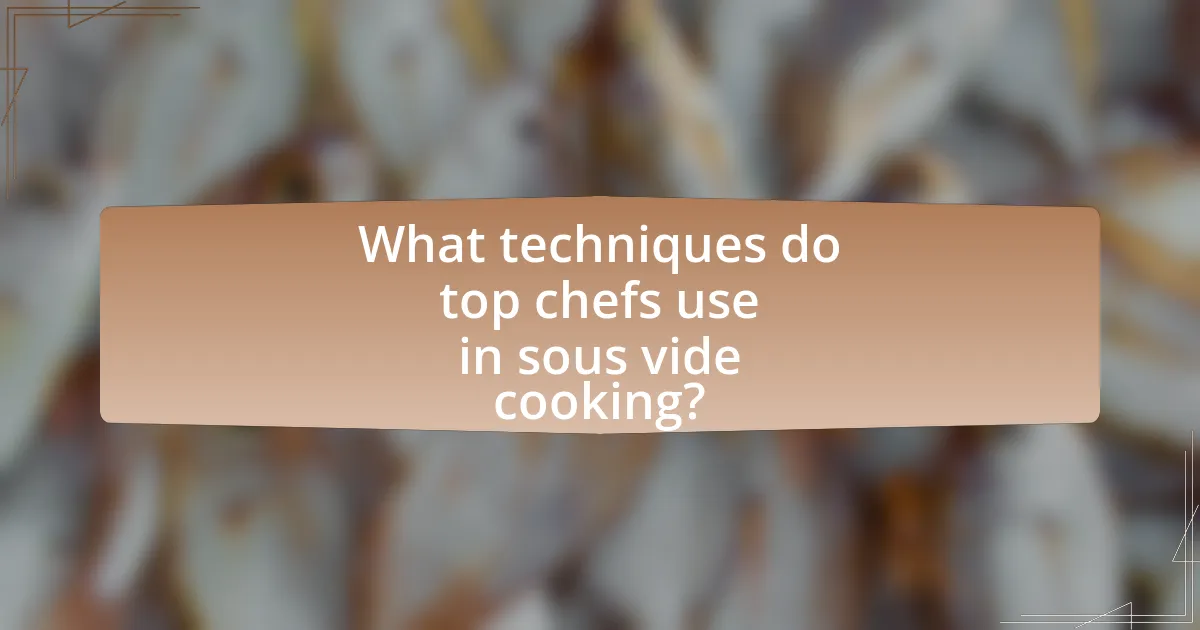
What techniques do top chefs use in sous vide cooking?
Top chefs use precise temperature control, vacuum sealing, and extended cooking times as key techniques in sous vide cooking. Precise temperature control allows chefs to cook food evenly and retain moisture, ensuring optimal texture and flavor. Vacuum sealing prevents oxidation and enhances the infusion of flavors, while extended cooking times enable the breakdown of tough fibers in meats, resulting in tender dishes. These techniques are supported by the scientific principle that cooking at lower temperatures for longer periods can yield superior results, as demonstrated in various culinary studies.
How do chefs achieve perfect doneness with sous vide?
Chefs achieve perfect doneness with sous vide by precisely controlling the cooking temperature and time for each type of food. This method allows chefs to cook food evenly and maintain the desired level of doneness throughout, as sous vide involves sealing food in a vacuum bag and immersing it in a water bath at a consistent temperature. For example, cooking a steak at 130°F (54°C) for one to four hours results in a medium-rare doneness, ensuring that the entire piece of meat reaches the same temperature without overcooking. This technique is validated by the fact that sous vide cooking eliminates the risk of temperature fluctuations, which can lead to uneven cooking and undesirable textures.
What are the best practices for seasoning before sous vide cooking?
The best practices for seasoning before sous vide cooking include using salt, herbs, and spices to enhance flavor while considering the cooking time and temperature. Salt is essential as it penetrates the food during the cooking process, improving taste and texture. For meats, a general guideline is to use about 1 teaspoon of salt per pound. Fresh herbs and spices should be added in moderation to avoid overpowering the dish, as sous vide cooking intensifies flavors. Additionally, seasoning should be done just before sealing the food in the vacuum bag to prevent moisture loss. This approach is supported by culinary experts who emphasize that proper seasoning enhances the overall quality of sous vide dishes.
How do chefs utilize sous vide for meal prep and batch cooking?
Chefs utilize sous vide for meal prep and batch cooking by precisely controlling cooking temperatures to enhance flavor and texture while ensuring food safety. This technique allows chefs to cook large quantities of food evenly and consistently, as items are sealed in vacuum bags and submerged in a water bath at a specific temperature for an extended period. For instance, cooking proteins like chicken or beef at low temperatures for several hours results in tender, juicy dishes that can be stored and reheated without loss of quality. Additionally, sous vide cooking minimizes food waste, as ingredients can be cooked in bulk and portioned for future use, streamlining kitchen operations and improving efficiency.
What innovative sous vide techniques are trending among chefs?
Innovative sous vide techniques trending among chefs include the use of multi-stage cooking, where ingredients are cooked at different temperatures and times to enhance flavor and texture. This method allows chefs to achieve precise doneness while infusing complex flavors. Additionally, the integration of sous vide with other cooking methods, such as finishing proteins with a quick sear or using a blowtorch for caramelization, is gaining popularity. These techniques not only improve the visual appeal of dishes but also enhance the overall taste experience. Chefs are also experimenting with sous vide to create unique infusions, such as flavored oils and spirits, by controlling temperature and time for optimal extraction.
How are chefs incorporating sous vide into modern cuisine?
Chefs are incorporating sous vide into modern cuisine by utilizing precise temperature control to enhance flavor and texture in dishes. This technique allows chefs to cook ingredients evenly and retain moisture, resulting in tender meats and perfectly cooked vegetables. For example, sous vide cooking can maintain the integrity of delicate proteins like fish, ensuring they are cooked to the desired doneness without overcooking. Additionally, chefs are using sous vide for meal prep and batch cooking, which streamlines service in busy kitchens. The method has gained popularity due to its ability to produce consistent results, as evidenced by its widespread adoption in high-end restaurants and culinary schools.
What unique flavor combinations are chefs experimenting with in sous vide?
Chefs are experimenting with unique flavor combinations in sous vide, such as citrus and herbs, coffee and spices, and fruit-infused meats. For instance, the pairing of lemon zest with rosemary enhances the flavor of chicken, while coffee rubs on beef create a rich, complex taste profile. Additionally, sous vide allows for the infusion of fruits like peaches or cherries into meats, resulting in unexpected sweetness and depth. These combinations leverage the precise temperature control of sous vide cooking to extract and meld flavors in ways that traditional methods cannot achieve.
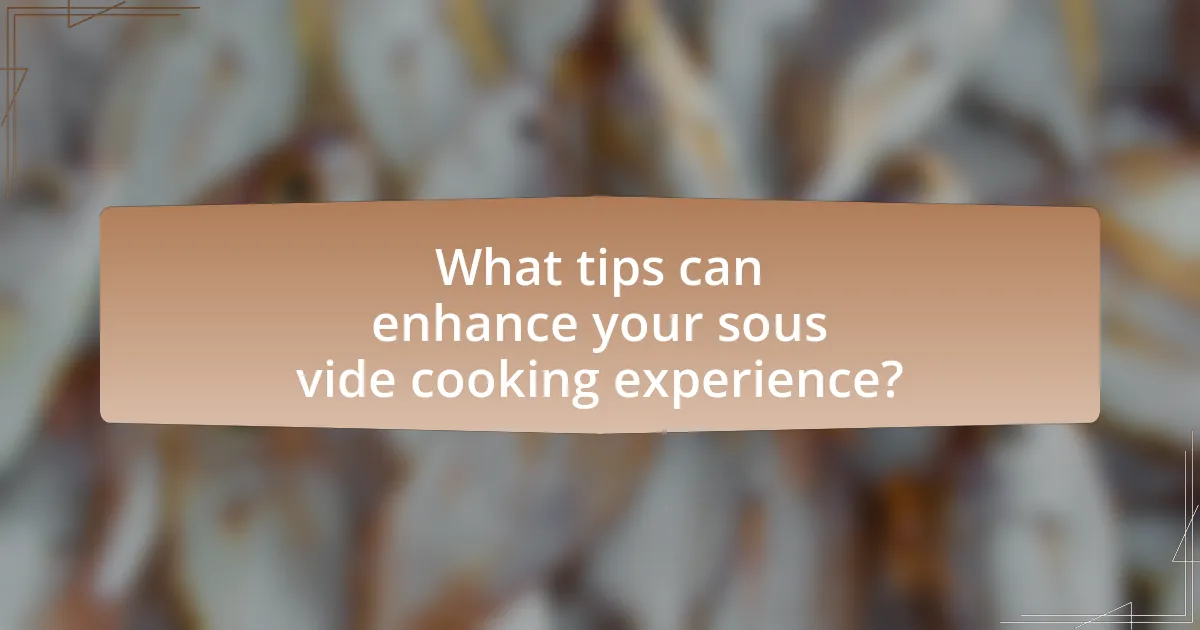
What tips can enhance your sous vide cooking experience?
To enhance your sous vide cooking experience, ensure precise temperature control by using a reliable immersion circulator. This device maintains consistent water temperature, which is crucial for achieving the desired doneness and texture in food. Studies show that cooking proteins at specific temperatures, such as 140°F for chicken breast, results in optimal tenderness and juiciness. Additionally, vacuum-sealing food properly prevents water from entering the bags, ensuring even cooking and flavor retention. Using a food-safe bag and removing as much air as possible can further improve results.
How can you troubleshoot common sous vide issues?
To troubleshoot common sous vide issues, first identify the specific problem, such as temperature inconsistencies, overcooked or undercooked food, or water displacement. For temperature inconsistencies, ensure the immersion circulator is calibrated correctly and that the water bath is not overcrowded, as this can hinder circulation. If food is overcooked, reduce cooking time or lower the temperature; conversely, if undercooked, increase the cooking time or temperature. Water displacement issues can be resolved by using vacuum-sealed bags properly or ensuring that the bags are fully submerged without trapping air. These troubleshooting steps are supported by sous vide cooking principles, which emphasize precise temperature control and proper food sealing techniques for optimal results.
What are the most frequent mistakes to avoid in sous vide cooking?
The most frequent mistakes to avoid in sous vide cooking include not preheating the water bath, using improper vacuum sealing techniques, and cooking at incorrect temperatures. Preheating the water bath ensures that food cooks evenly and reaches the desired doneness, as starting with a cold bath can lead to uneven cooking. Improper vacuum sealing can result in water entering the bag, compromising food quality and safety. Cooking at incorrect temperatures can lead to undercooked or overcooked food, as precise temperature control is essential for achieving the desired texture and flavor in sous vide dishes.
How can you ensure food safety while using sous vide?
To ensure food safety while using sous vide, maintain precise temperature control and adhere to recommended cooking times. Cooking food at the correct temperature, typically between 130°F to 185°F, for the appropriate duration effectively kills harmful bacteria. For instance, cooking chicken at 165°F for just a few seconds is sufficient to eliminate pathogens, while cooking it at 140°F requires a longer time, such as 1 hour, to achieve the same safety level. Additionally, using vacuum-sealed bags prevents contamination and ensures even cooking. Following these guidelines minimizes the risk of foodborne illnesses associated with sous vide cooking.
What are the best practices for sous vide cooking at home?
The best practices for sous vide cooking at home include using high-quality vacuum-sealed bags, maintaining precise temperature control, and ensuring proper food safety measures. High-quality vacuum-sealed bags prevent water from entering and ensure even cooking, while precise temperature control allows for consistent results, as sous vide relies on cooking food at specific temperatures for extended periods. Food safety measures, such as cooking food at the appropriate temperature for the recommended time, help eliminate harmful bacteria, ensuring that the food is safe to consume. For instance, cooking chicken at 165°F for at least 1 hour effectively kills pathogens, making it safe to eat.
How can you adapt sous vide techniques for different types of food?
To adapt sous vide techniques for different types of food, adjust cooking times and temperatures based on the specific food’s characteristics. For example, tender cuts of meat like steak can be cooked at 130°F for 1 to 4 hours, while tougher cuts like brisket require 155°F for 24 to 36 hours to break down collagen effectively. Vegetables, on the other hand, typically cook at lower temperatures, such as 183°F for 30 to 60 minutes, depending on the type. This method ensures optimal texture and flavor by allowing precise control over cooking conditions, which is supported by research indicating that sous vide cooking enhances the retention of nutrients and flavors compared to traditional methods.
What resources are available for learning more about sous vide cooking?
Books, online courses, and cooking blogs are valuable resources for learning about sous vide cooking. Notable books include “Sous Vide for Everybody” by America’s Test Kitchen, which provides comprehensive techniques and recipes. Online platforms like MasterClass offer courses taught by renowned chefs, such as Thomas Keller, who share expert insights into sous vide methods. Additionally, popular cooking blogs like Serious Eats and Sous Vide Supreme provide detailed guides, tips, and community discussions that enhance understanding of sous vide techniques. These resources collectively offer a well-rounded foundation for mastering sous vide cooking.


